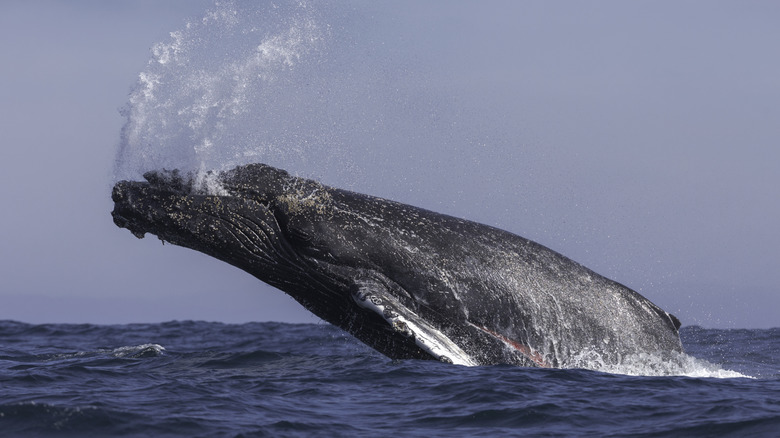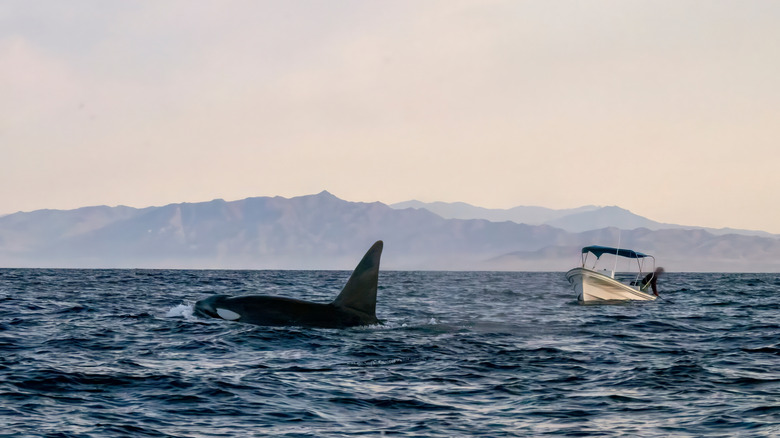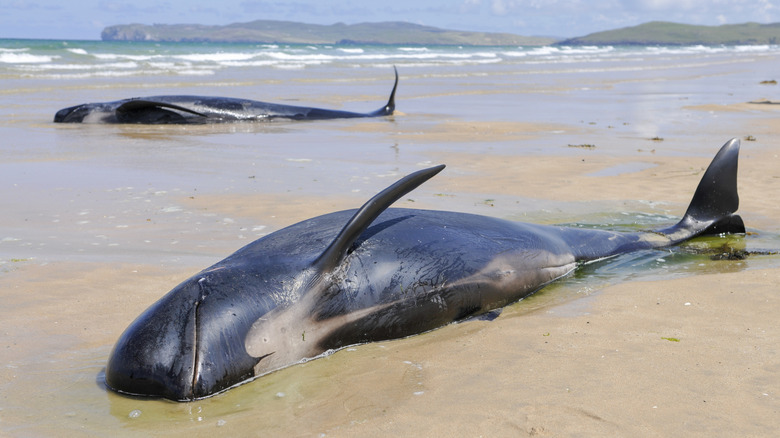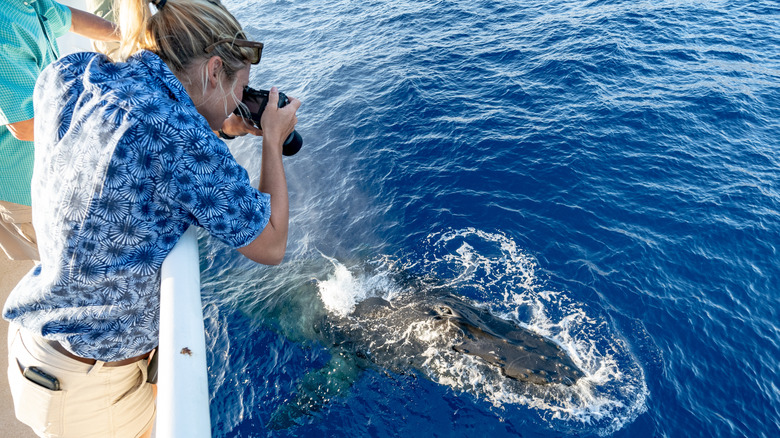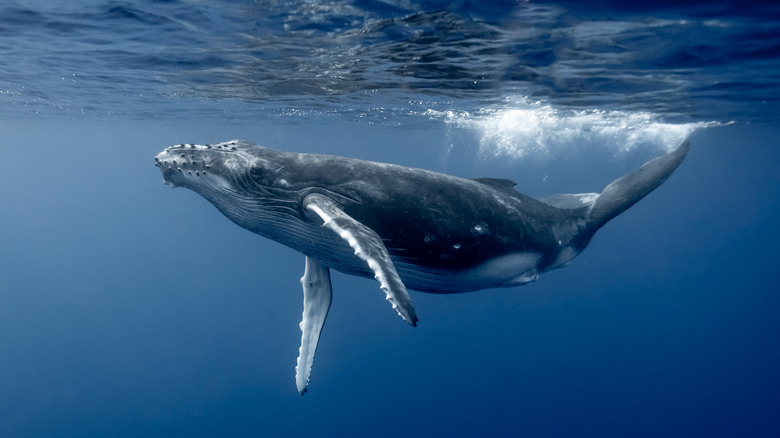Take These Steps Immediately If You Spot An Endangered Whale
Many people picture powerful orcas like the one from "Free Willy" or destructive sperm whales like the one in "Moby Dick" when they think of massive sea mammals. However, despite their large size and apparent invincibility, whales sometimes find themselves in vulnerable positions and need the assistance of us humans. Just like great white sharks, dolphins, sea lions, and other sea creatures, whales can fall victim to ship strikes, get entangled in fishing gear, or end up beached for one reason or another. If you ever spot a whale in danger, you'll want to take these steps so it can get the care it needs, if possible.
Spotting a whale in any condition is a rare occurrence that will undoubtedly make you want to whip out your cell phone and start snapping pics. You might even want to do more, depending on your location and proximity to the mammal. However, without knowing for certain what you should do if the whale is injured or incapacitated, you could actually worsen the situation and unintentionally cause more harm. Following these steps responsibly can support the ongoing effort to preserve these majestic sea creatures, and increase the odds of a happy ending.
Stay calm and keep a safe distance from the whale
Once you recognize that the whale needs help, you may reflexively panic or become overly emotional, but this will only hinder your good intentions. Do your best to stay calm at the sighting. Take deep breaths if you have to and maintain a distance of at least 150 feet from the whale. Injured animals, including dolphins and sea lions, can behave aggressively or unpredictably if they feel threatened by a nearby or approaching human, even a human trying to help. If other people are nearby, encourage them to keep their distance as well.
Another thing to keep in mind during those first few minutes after spotting the animal is that you won't be able to control everything that happens over the next few hours. It's natural to want to assist, to hope circumstances won't worsen, and to expect the whale to be rescued and make a full recovery. Unfortunately, though, despite all your efforts, the outcome might not be a happy one, but don't blame yourself if this is the case. Just continue to remain calm as you follow the next steps below.
Report the whale sighting via phone or distress alert
If the whale is on land, you can report the sighting by simply calling your local marine mammal stranding network. Visit the NOAA Fisheries website and select your region for the best number to call. You can also call 1-877-WHALE-HELP (942-5343) or use the Dolphin & Whale 911 app. If you're out at sea in U.S. waters, report the whale to the U.S. Coast Guard on VHF Channel 16. Provide as much information as you can, including the whale's size and species (if known), location using GPS or nautical information, and details about its condition.
Wait for help to arrive, but keep in mind that it might not arrive as quickly as you'd like. The wait time depends on a number of factors, including the distance of the whale from the rescuers, the number of rescuers available, weather conditions, and time of day. Try to be patient and fight the temptation to take matters into your own hands.
Take photos or video of the whale
Seeing a whale in the wild isn't common, so you're likely going to immediately go into "pics or it didn't happen mode" without anyone telling you to. In fact, it will probably be the very first thing you do. Taking photos or video, or both, can be helpful during a whale rescue, so documenting the encounter is encouraged both before and after calling to report the sighting.
You might be able to share your footage with the rescuers via cell phone or email as you wait for their arrival. This information can help them be better equipped for the rescue. It can also help with questions that you don't have the answers to, such as the species and condition of the whale. Just keep the distance recommendation of 150 feet in mind; avoid getting too close to the whale as you take your photos and film.
Don't attempt to rescue the whale
Unless you're a trained, experienced marine life rescuer or marine biologist who knows what you're doing, it's best not to attempt to rescue the whale yourself. For example, if you see a beached whale, you and others around you may think that pushing it back into the water would be the best thing to do. However, doing this could put both the whale and you in danger, as well as any other people nearby.
Another possible scenario is encountering an entangled whale while scuba diving or on a boat. You might have a knife with you and think, "If only I can get close enough, I can cut the netting and free the whale in a few minutes." The executive director and founder of the Great Whale Conservancy had this very experience when he came across a humpback whale entangled in gillnet in the Sea of Cortez. Despite his experience with sea mammals and having a team with him, it took over an hour to free the whale. The rescue was documented and shared by The Dodo.
You can find many other rescue stories similar to this. After the initial sighting, some rescues took hours or days and involved fully equipped rescue teams. Sadly, rescuers have died in their attempts. Being able to safely and successfully rescue an entangled whale alone without experience is rare, if not impossible, and extremely risky. It might even be illegal, depending on the species, so it's best to leave it to the professionals.
Wait for help to arrive if you can
After reporting an injured whale sighting, stay on the scene until a rescue team arrives, but only if it's safe to do so. Continue to maintain your distance and encourage others to do the same. Your presence may also prevent other people from making unwise or otherwise dangerous decisions involving the whale. Monitor the whale as time progresses, in case its condition changes. Continue to film and/or take photos, keeping in mind that the rescuers may want to see your footage upon arrival or after.
If, for any reason, you're unable to stay with the whale until help arrives, be sure the rescue organization you called has the correct location and your contact information. You might also want to ask someone else nearby if they'd be willing to stay with the whale. Just be sure to tell them that getting too close to the whale could be dangerous.
When the team arrives, the rescuers will work as quickly and safely as possible to save the whale. They will have specialized equipment and the skills to use it. In some cases, they might even transport the whale to a rehabilitation facility and relocate it when they release it back into the wild. Want to know more about other sea life rescues? Check out the strange thing happening with California's sea lions.
